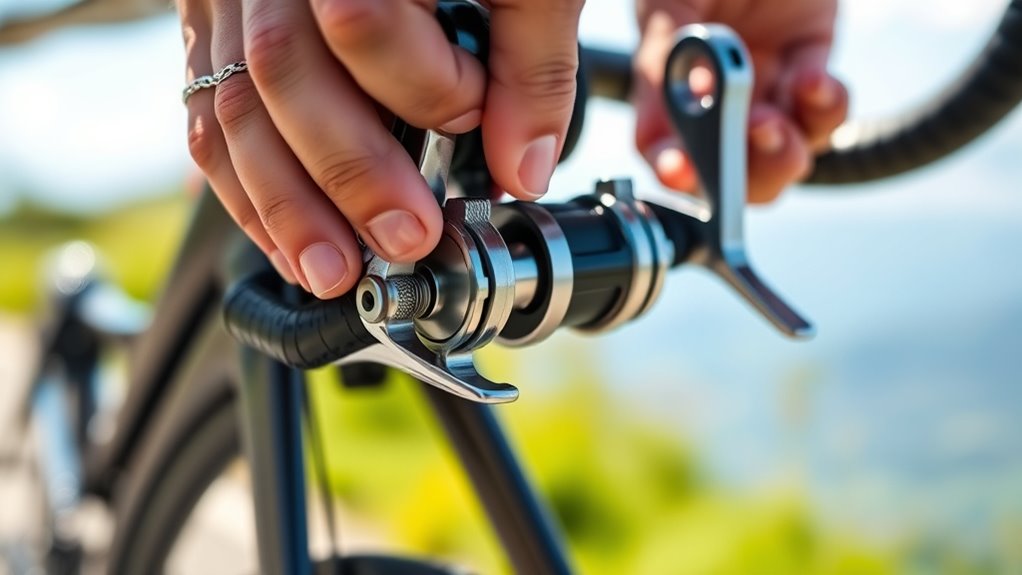To adjust your bicycle brakes for maximum performance, start by inspecting the brake pads and calipers to guarantee they’re clean and properly aligned. Next, tweak the cable tension using the barrel adjuster or cable clamp until the brake lever feels firm and responsive. Center the calipers so pads hit the rim or rotor evenly, and check they’re aligned correctly. Fine-tuning these steps will improve braking efficiency, and keeping them in top shape may require some extra tips you’ll find below.
Key Takeaways
- Check and adjust brake cable tension using barrel adjusters for responsive and smooth braking.
- Ensure brake calipers are properly centered and aligned for even pad contact on rims or rotors.
- Inspect and set brake pads so they contact the braking surface squarely and evenly.
- Test brake response by squeezing the lever, adjusting tension or caliper position as needed for optimal feel.
- Perform regular maintenance, including cleaning, pad replacement, and system checks, to maintain peak brake performance.
Understanding Your Bicycle Brake System
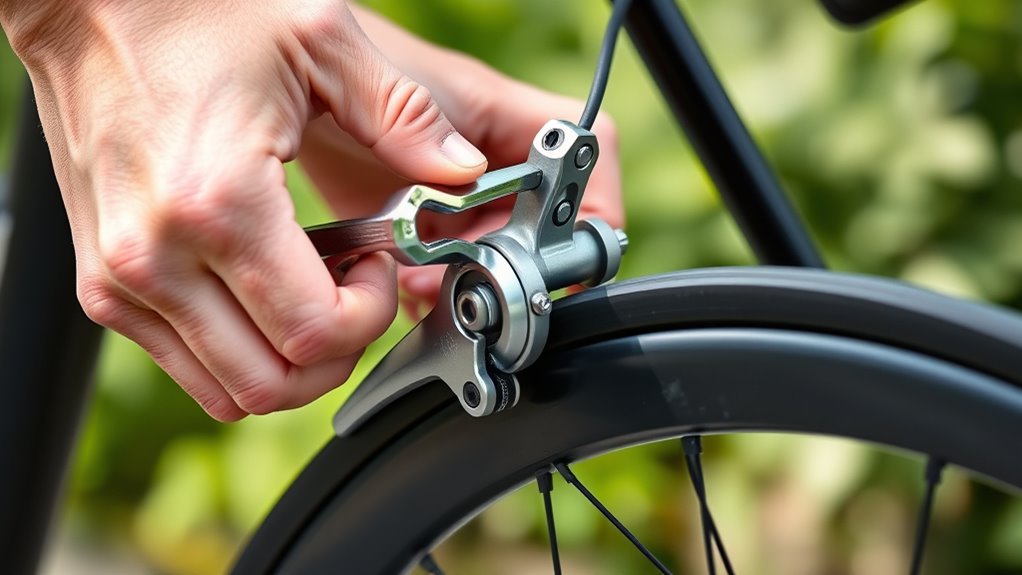
To properly adjust your bicycle brakes, you first need to understand how the brake system works. Modern bikes often use disc brakes, which rely on brake fluid to transfer force from the lever to the calipers. When you squeeze the brake lever, brake fluid pushes pistons that clamp the disc brake rotor, stopping your wheel. Unlike traditional rim brakes, disc brakes provide consistent stopping power, especially in wet conditions. Understanding water-based systems is essential because they are common in hydraulic disc brakes and require proper maintenance of the brake fluid. It’s crucial to recognize that the brake fluid must be maintained at the right level to guarantee proper function. Maintaining regular brake fluid checks can prevent air bubbles or contamination that might impair braking performance. Knowing how your disc brake system operates helps you identify issues early and make effective adjustments. Proper brake fluid maintenance is vital for ensuring safe and reliable braking performance on your bike. Additionally, being aware of common brake issues can help you troubleshoot problems before they become serious. This understanding forms the foundation for maintaining safe, reliable braking performance on your bike.
Inspecting Your Brakes Before Adjustment
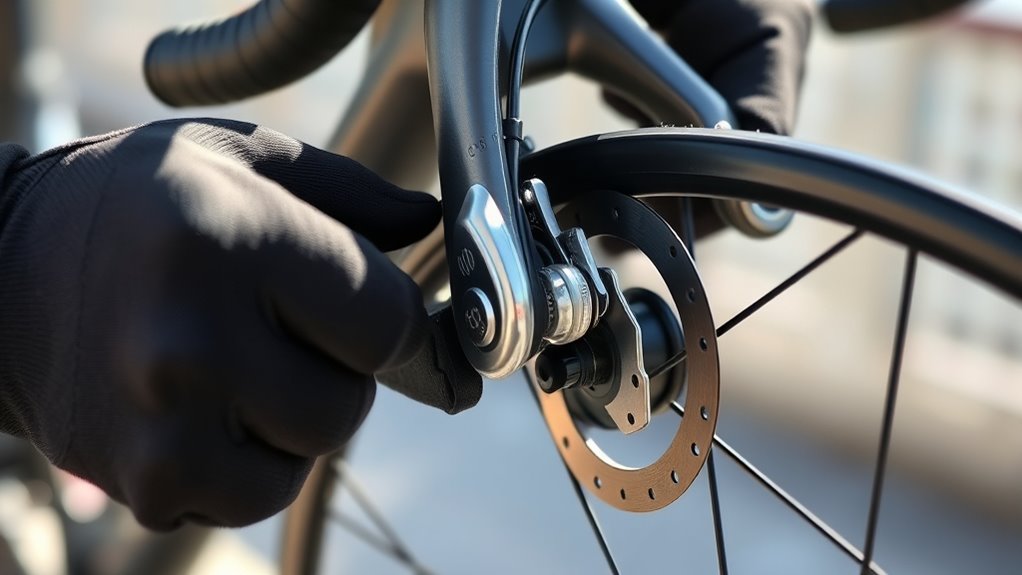
Before you start adjusting your brakes, it’s essential to thoroughly inspect them for any signs of wear or damage. Check the brake pads for thinning or uneven wear, paying attention to brake pad materials—some materials wear faster or perform better in different conditions. Worn brake pads can reduce braking effectiveness and damage the rim. Additionally, inspecting portable camping toilets can help ensure your camping setup remains comfortable and hygienic during maintenance stops. Next, examine rim compatibility, ensuring the rim surface is clean, smooth, and free of debris or cracks. Look for any dents or deformation that could interfere with proper braking. Verify that the brake pads make proper contact with the rim when engaged, without rubbing or gaps. Proper automation technologies can enhance your ability to detect issues early, helping to identify potential problems before they affect performance. Incorporating sensor-based diagnostics can further improve the accuracy of your inspections. Implementing regular maintenance routines is also crucial for keeping your brakes in optimal condition. Regularly monitoring air quality around your workspace can help you identify any environmental factors that might affect brake components, such as dust or pollutants. This inspection helps identify potential issues early, ensuring your brakes perform safely and efficiently once you proceed to adjustment.
Adjusting Brake Cable Tension

You need to tighten or loosen the brake cable to guarantee proper tension. Make sure the cable is snug enough for responsive braking without causing pull or stiffness. After adjusting, test your brakes to confirm they respond quickly and evenly. Incorporating feedback from these tests can help fine-tune your brake performance for safer riding, especially as automated insights and real-time adjustments become more prevalent in cycling maintenance.
Proper Cable Tightening
Proper cable tension is essential for effective braking performance. When your cable is too loose, your brake response becomes sluggish; too tight, and you risk excessive wear or brake squeal. To tighten the cable, start by checking the brake pad alignment and replacing them if necessary. Lubricate the cable to ensure smooth operation. Then, adjust the barrel adjuster or cable clamp to achieve the right tension. Incorporating ergonomic considerations into your setup can help reduce strain and improve overall control during riding. Additionally, understanding brake system mechanics can assist in troubleshooting common issues effectively. Being familiar with mechanical adjustments can further optimize your braking system. Recognizing the importance of automatic safety features can also help in maintaining reliable braking performance. Keep these tips in mind:
- Test brake lever feel for firm, responsive action
- Use cable lubrication for smoother pull
- Ensure brake pads are close but not rubbing
- Tighten cable incrementally to avoid over-tensioning
- Recheck after adjustments for consistent braking
Proper cable tightening ensures your brakes perform reliably, keeping your ride safe.
Checking Brake Response
How can you tell if your brake cable tension is just right? First, squeeze the brake lever; it should engage smoothly without feeling too loose or too tight. If the brake response feels sluggish or the lever pulls too close to the handlebar, your cable might be too loose. Proper airless paint sprayer maintenance can help ensure consistent performance, similar to how correct cable tension maintains reliable braking. Conversely, if the lever feels stiff or the brake pads are hard to release, tension is too tight. Check the wheel alignment—misaligned wheels can affect brake response, so ensure everything lines up properly. Also, inspect the brake fluid if you have hydraulic brakes, as low or contaminated fluid can impair performance. Adjusting cable tension and ensuring proper wheel alignment help your brakes respond accurately, providing safe, reliable stopping power every ride. Additionally, regularly inspecting brake components and cable routing can prevent performance issues before they arise. Maintaining proper cable tension is essential for optimal braking performance, ensuring safety and efficiency on every ride.
Centering the Brake Calipers
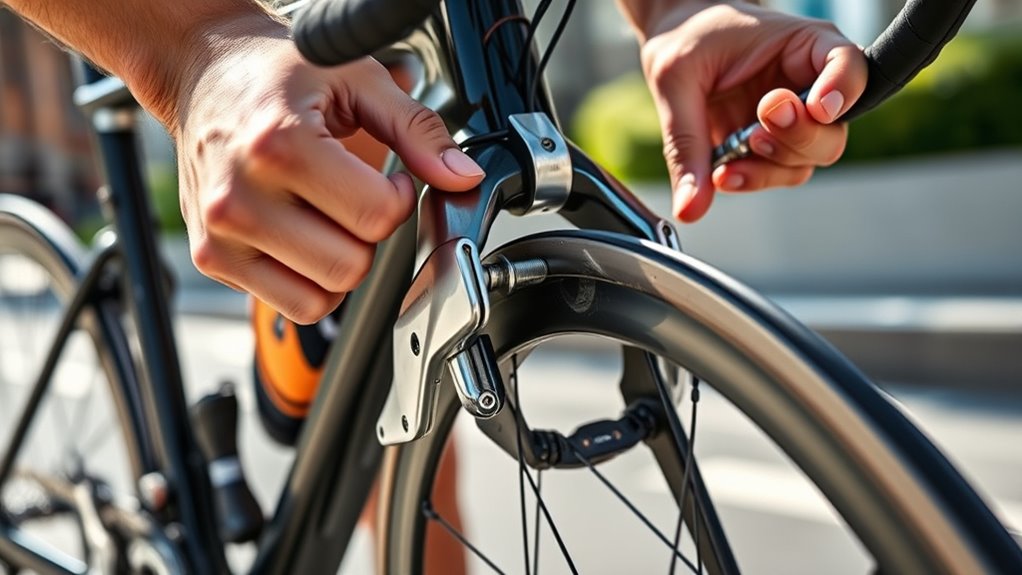
To guarantee your brakes work smoothly, you need to center the calipers properly. Start by aligning the brake pads so they hit the rim evenly on both sides. You should also ensure that the toilet components are clean and free of debris to maintain optimal performance. Additionally, making sure that the caliper spacing is equal helps your braking be balanced and effective. Proper caliper adjustment ensures consistent braking force and prolongs the lifespan of your brake components. Regularly inspecting and maintaining the skewed alignment of the calipers can prevent uneven wear and improve braking response. Recognizing the importance of artistic innovation in modern design can inspire more effective adjustments and enhancements in your bicycle maintenance routine.
Aligning Brake Pads Precisely
When aligning brake pads precisely, making sure the calipers are centered over the rim is essential for consistent braking performance. Proper alignment guarantees the brake pad material contacts the rim evenly, preventing uneven wear and noise. To achieve this, loosen the caliper bolts slightly, then squeeze the brake lever to center the pads automatically. Carefully adjust the position so each pad is equidistant from the rim’s edges. Keep these tips in mind: – Check for any debris or dirt that might interfere – Ensure brake pad material is evenly worn – Replace brake pads if they’ve become too thin – Confirm the calipers are centered before tightening bolts – Test the brakes for even contact and stopping power. Ensuring your brake system is properly tuned can also improve overall braking performance, prolonging the lifespan of your brake components. Regularly inspecting the calipers and maintaining proper alignment can prevent issues caused by cybersecurity vulnerabilities, ensuring a safer ride. Precise alignment extends brake life and helps you avoid frequent brake pad replacement, maintaining peak performance.
Ensuring Equal Caliper Spacing
Making sure the equal caliper spacing is essential for balanced braking and even brake pad wear. To achieve this, start by loosening the mounting bolts slightly.
Squeeze the brake lever to center the caliper over the rotor, then tighten the bolts while holding the lever. Check the caliper clearance on both sides; it should be equal, with no wobbling or rubbing.
Proper caliper centering prevents uneven brake pad wear and improves braking performance. If the caliper is misaligned, you might notice inconsistent braking or noisy pads.
Adjusting caliper positioning ensures the brake pads contact the rotor evenly, extending pad life and providing smooth, reliable stops. Regularly verifying caliper spacing guarantees *ideal* brake function and safer rides.
Setting the Brake Pad Alignment

Have you ever noticed your brake pads aren’t hitting the rim evenly? Properly setting the brake pad alignment guarantees peak braking performance and prevents uneven wear.
Ensure brake pads contact the rim evenly for optimal performance and even wear.
First, check that your brake pad material is suitable for your rim type. Align the pads so they contact the rim surface squarely, avoiding the tire or spokes.
Keep rim compatibility in mind, ensuring the pads match your wheel’s material—metal or alloy.
To do this, loosen the brake bolt, position the pad so it touches the rim evenly, then tighten securely.
Remember these tips:
- Position pads slightly below the rim’s center
- Ensure the entire pad contacts the rim
- Keep pads parallel to the rim surface
- Avoid touching the tire or spokes
- Double-check for equal contact on both sides
Testing and Fine-Tuning Your Brakes
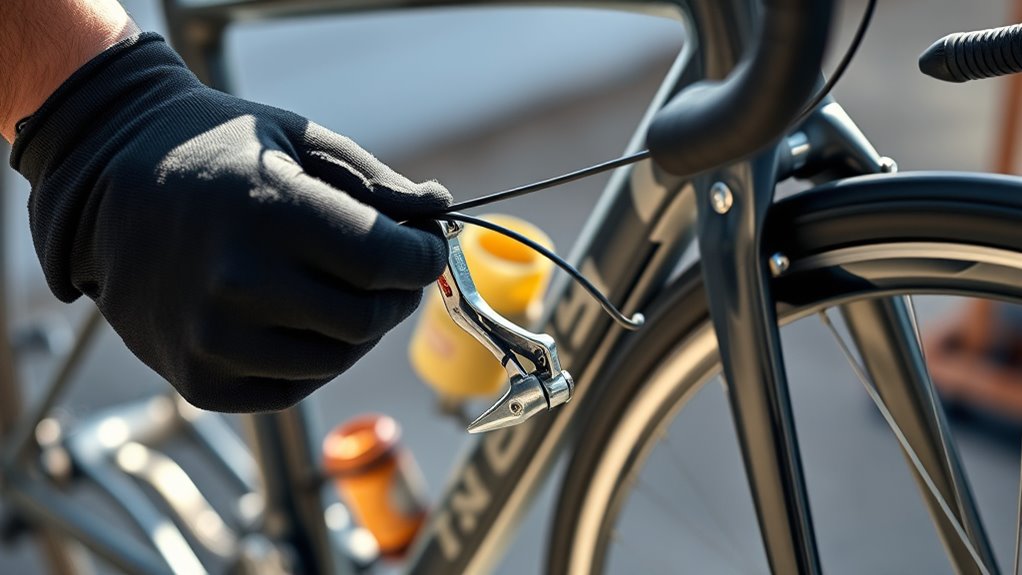
After adjusting your brake pad alignment, it’s time to test your brakes to make sure everything works smoothly.
Check how the brake pads contact the rim or disc, ensuring even pressure across the surface.
Consider your brake pad materials—rubber, resin, or metal—and how they influence braking performance and noise.
If you have hydraulic brakes, squeeze the lever firmly to feel for firm, consistent response.
If you ride mechanical brakes, pull the cable to check for slack or uneven engagement.
Fine-tuning might involve adjusting the brake caliper tension or lever reach to improve feel.
Test your brakes in a controlled environment before hitting the road, ensuring that both hydraulic and mechanical systems respond reliably and stop your bike safely.
Maintaining Your Brakes for Long-Term Performance

To keep your bicycle brakes performing reliably over time, regular maintenance is essential. Proper care prevents issues like squeaking, reduced stopping power, and fluid leaks.
For disc brakes, regularly check and replace brake fluid to guarantee ideal braking. Keep discs clean and free from dirt or oil that can impair performance. Inspect brake pads for wear and replace them when necessary. Tighten loose bolts and ensure proper alignment.
For disc brake maintenance, occasionally bleed the system to remove air bubbles, which can diminish braking efficiency. Additionally, lubricate moving parts and cables where appropriate.
Regularly inspecting these components helps extend the lifespan of your brakes and ensures safe, smooth stops every ride. Staying proactive saves you time and money in the long run.
Frequently Asked Questions
How Often Should I Adjust My Bike Brakes for Optimal Performance?
You should check your bike brakes regularly, ideally every few rides, to guarantee optimal performance. Look for signs like squeaking or reduced stopping power.
When needed, replace brake pads and lubricate brake cables to keep everything functioning smoothly.
If your brakes feel less responsive or the brake pads are worn down, it’s time for adjustments to maintain safety and efficiency during your rides.
Can I Adjust Brakes Without Removing the Wheel?
Yes, you can adjust your brakes without removing the wheel. Start by checking the brake pad alignment and ensuring the pads hit the rim evenly.
If needed, loosen the cable and adjust the cable tension to improve braking. Fine-tune the pad position so they don’t touch the tire or miss the rim.
This way, you maintain peak performance without the hassle of wheel removal.
What Tools Are Needed for Brake Adjustments?
To adjust your bicycle brakes, you’ll need a few tools. A Allen wrench or hex key helps with caliper alignment, ensuring the brake pads sit evenly on the rim.
A Phillips or flat-head screwdriver is useful for fine-tuning cable tension. Additionally, pliers can help grip and adjust cable housing.
These tools make it easier to keep your brakes responsive and smooth, ensuring safe, reliable stopping power.
How Do I Know When Brake Pads Are Worn Out?
You might notice a squealing sound or decreased braking power, which signals brake pad wear. Sometimes, you’ll see the brake pads getting thin, less than a quarter-inch thick, or even exposing the metal backing.
When this happens, it’s time for brake pad replacement. Regularly inspecting your brake pads helps prevent damage to your wheels and guarantees your bike stops safely.
Stay attentive to these signs, and you’ll keep riding smoothly.
Are There Different Brake Adjustment Techniques for Disc and Rim Brakes?
Yes, there are different techniques for disc brake maintenance and rim brake calibration.
For disc brakes, you typically check rotor alignment and pad clearance, adjusting calipers if needed.
Rim brakes require you to center the brake arms and set cable tension properly.
You’ll find that adjusting disc brakes involves fine-tuning calipers and rotors, while rim brake calibration concentrates on pad positioning and cable tension.
Both methods ensure smooth, effective braking.
Conclusion
Regularly adjusting your bike brakes can improve stopping power and safety. Did you know that properly maintained brakes can reduce your stopping distance by up to 30%? By inspecting, adjusting, and maintaining your brakes, you guarantee a smoother, more reliable ride. Don’t overlook this simple maintenance—taking a few minutes now can save you from costly repairs later. Keep your brakes in top shape and enjoy safer, more confident cycling every time you hit the road.
